There are several birds in the Netherlands that dive under water in search for food. A well-known example is of course the kingfisher (Alcedo atthis), which often dives into the water from a branch and then comes out with a stickleback, dragonfly larva or another snack. Or the grebe (Podiceps cristatus), which, like the black-necked grebe (Podiceps nigricollis), little grebe (Tachybaptus ruficollis) and other grebe-like species, swim underwater to catch a meal. There are also ducks that dabble like the mallard (Anas platyrhynchos) or dive like the tufted duck (Aythya fuligula). One species however takes it to a different level, by walking over the bottom of streams, underneath the water surface: the dipper (Cinclus cinclus).
Water starling
Its Dutch name is waterspreeuw, literally translated as water starling. This name is not that strange, because the bird looks a bit like songbirds as the starling (Sturnus vulgaris), blackbird (Turdus merula) and song thrush (Turdus philomelos). It is not without reason that its name in German is Wasseramsel, literally water blackbird. And in Friesland, a province in the north of the Netherlands with its own language, it is called wetterlyster, literally water thrush. The dipper belongs to the family Cinclidae (which in turn is part of the order of passerine birds Passeriformes). The Cinclidae is a small family containing solely the genus Cinclus. All members of this genus have the same way of collecting food: walking underwater in search of larvae of mayflies and caddisflies. There are only five species of this genus worldwide, of which only one occurs in Europe and that is this dipper.
Subspecies
It is a bit more nuanced, because the dipper that you see in Scandinavia is a slightly different subspecies than the one in Turkey and there is a different subspecies again in Scotland. As a matter of fact, dippers in the west of Scotland are different from the ones in the eastern part. In Europe there are five different subspecies of the dipper. In total there are twelve subspecies worldwide. (There was another thirteenth subspecies, an endemic to Cyprus, which means that it lived only at this island. This subspecies however, has been extinct since 1945.) In previous blogs about the yellow wagtail (Motacilla flava) and the long-tailed tit (Aegithalos caudatus), I have already mentioned subspecies. Subspecies are very similar, but they have evolved further in different parts of the world, causing – minimal – differences. Subspecies can also mate with each other, creating hybrid forms.
Rapids
You can see two subspecies of the dipper in the Netherlands. First of all, there is the black-bellied dipper (Cinclus cinclus cinclus). This bird has a somewhat scattered breeding area, some of which are in Central France and Northwest Spain, but also at Corsica and Sardinia. And some breed much further north in Scandinavia and the Baltic states. In the area in between, this subspecies hardly occurs, at least not as a breeding bird. Dippers are true resident birds, but when the streams and brooks freeze over, they migrate southwards. And every now and then a few turn up in the Netherlands in winter, looking for brooks and rapids to forage in, although these are fairly sparse in our country. This black-bellied dipper has, as the name suggests, a dark belly beneath the white throat patch and chest. Not really black; the colour of the belly feathers is just as dark as that of the rest of the plumage.
Ardennes
The other species is the red-bellied dipper (Cinclus cinclus aquaticus). As the name implies, the belly of this subspecies just below the white breast is distinctly reddish. This is clearly visible in this photo by Jeroen Aarsen on Waarneming.nl. This subspecies is mainly found in Central and Southern Europe. The northernmost limit of its breeding area is in Belgium, where the bird breeds near fast-flowing brooks in the Ardennes. Between 2008 and 2012 there were an estimated 800 to 1000 breeding pairs every year. In the last century the bird also occasionally bred in the Dutch province Limburg. The last known breeding case here was in 1994 in the Geul valley. Although no recent breeding cases are known, they are observed every year in the south of Limburg. But you will not encounter this red-bellied dipper much further north in the Netherlands.
Two different subspecies
In the United Kingdom you normally won’t see the two subspecies I mentioned above. But there are two other subspecies. In the North, Central and West England, Wales and Scotland (except the western part) you will find Cinclus cinclus gularis. Ireland and the western part of Scotland are home to Cinclus cinclus hibernicus. Both are called the white-throated dipper in English. I couldn’t find specific differences between these two species, they will be very minimal but if you can tell me the differences, I’ll be very pleased.
Bottom runner
In my introduction I already wrote that the dipper has a very strange and unique way of foraging. It’s able to fully dive under water and literally walk at the bottom of a fast-flowing stream. The birds in the dipper family are the only birds on earth that can do this. It can only perform this trick in running water. The bird holds its head against the current and holds its tail up, so that the water current presses it against the bottom. It cannot do this in slow-flowing or stagnant water. But even then it searches for food under water, swimming with its wings and legs. In the video below of my favourite nature programme BBC Winterwatch you can clearly see how the bird does this and that it isn’t even shy of a dive under the ice. To protect its eyes, it closes the third eyelid when swimming underwater, so that it has a kind of diving mask.
Not shy
Recently (from 24 to 26 October 2020) a black-bellied dipper in turned up in my neighbourhood. My last – and only – sighting of a dipper had been in November 2012 and I couldn’t make a photo of it then. So this was a great opportunity to photograph the bird. Unsurprisingly, I was not alone. A dozen bird watchers and photographers had gathered right next to the A7 motorway to observe the bird. This bird did not get flustered by the large number of telephoto lenses and telescopes pointed at it. And it was not shy at all, a hallmark of black-bellied dippers. Perhaps this is because black-bellied dippers lives in the vast forests of Scandinavia and hardly see any people. When they have found a place to forage, they don’t let themselves be chased away easily. Red-bellied dippers are known to be much more shy and are much more difficult to approach. They fly away immediately when they are even slightly disturbed. This dipper hopped from stone to stone and every now and then its head would go under water to catch a larva or other delicacy. And of course it sometimes disappeared completely into the stream to reappear further up. Wonderful to watch this beautiful but rare bird.
Sources:
- en.wikipedia.org
- www.rspb.org.uk
- www.etymologiebank.nl (in Dutch)
- Sovon Vogelonderzoek Nederland 2019. Vogelatlas van Nederland. Broedvogels, wintervogels en 40 jaar verandering. Vierde druk, Kosmos Uitgevers, Utrecht/Antwerpen (in Dutch)
This item was originally published in Dutch on November 10th 2020



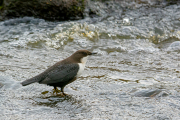

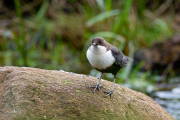
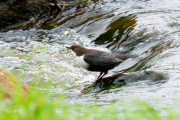
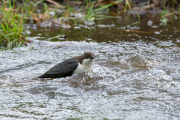
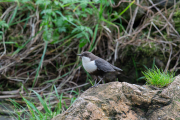
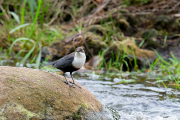
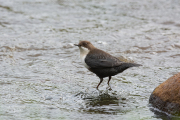
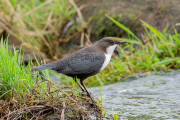
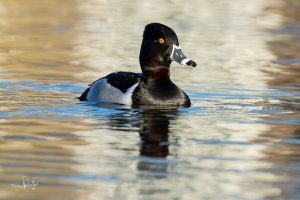
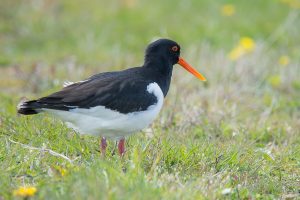
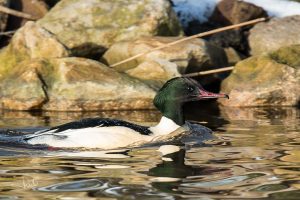
Fascinating and informative. Thank you.
Thanks Gillian! 🙂
I really enjoyed reading your study of the dipper Theo, thanks for posting. I live in the UK and I monitor dipper nests and ring the chicks on my local River Redlake on the Welsh border. They are indeed fascinating birds. Without studying their taxonomy I like to think of them as water wrens as their body shape, behaviour, song and even nest design and materials seem so similar that I think there must be a common ancestry. Thanks for sharing your love of nature with us.
Thank you for your very thoughtful response, Lloyd! How nice that fellow dippers can follow so close. Here in the north of the Netherlands we have to make do with a bird that occasionally shows up during the migration. Indeed, there could be a relationship between the wren and the dipper, just like the bluethroat.